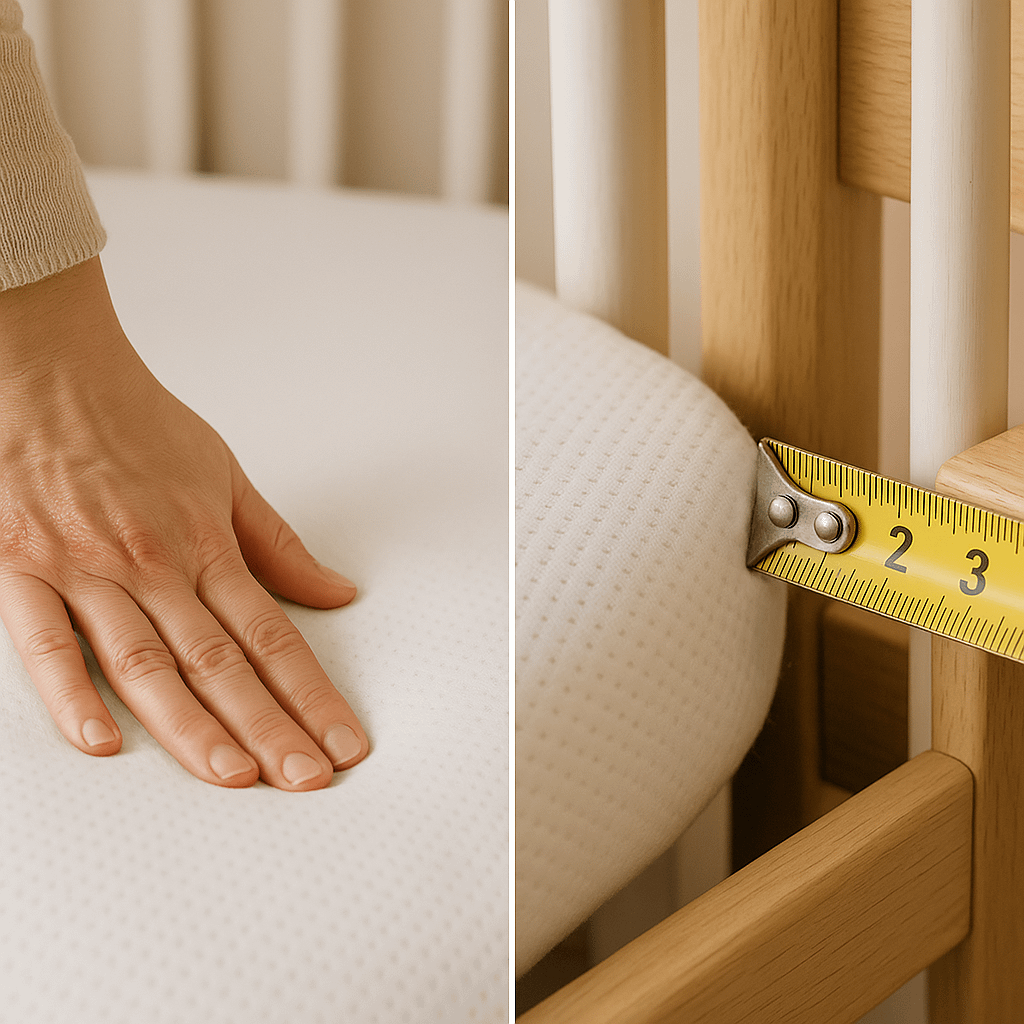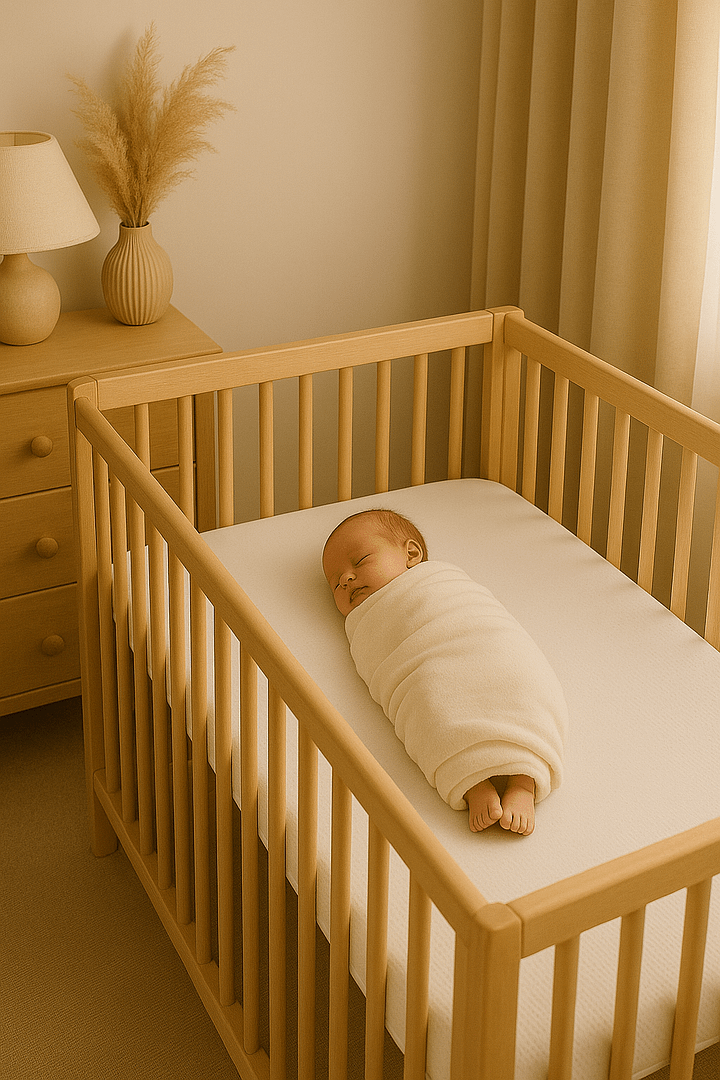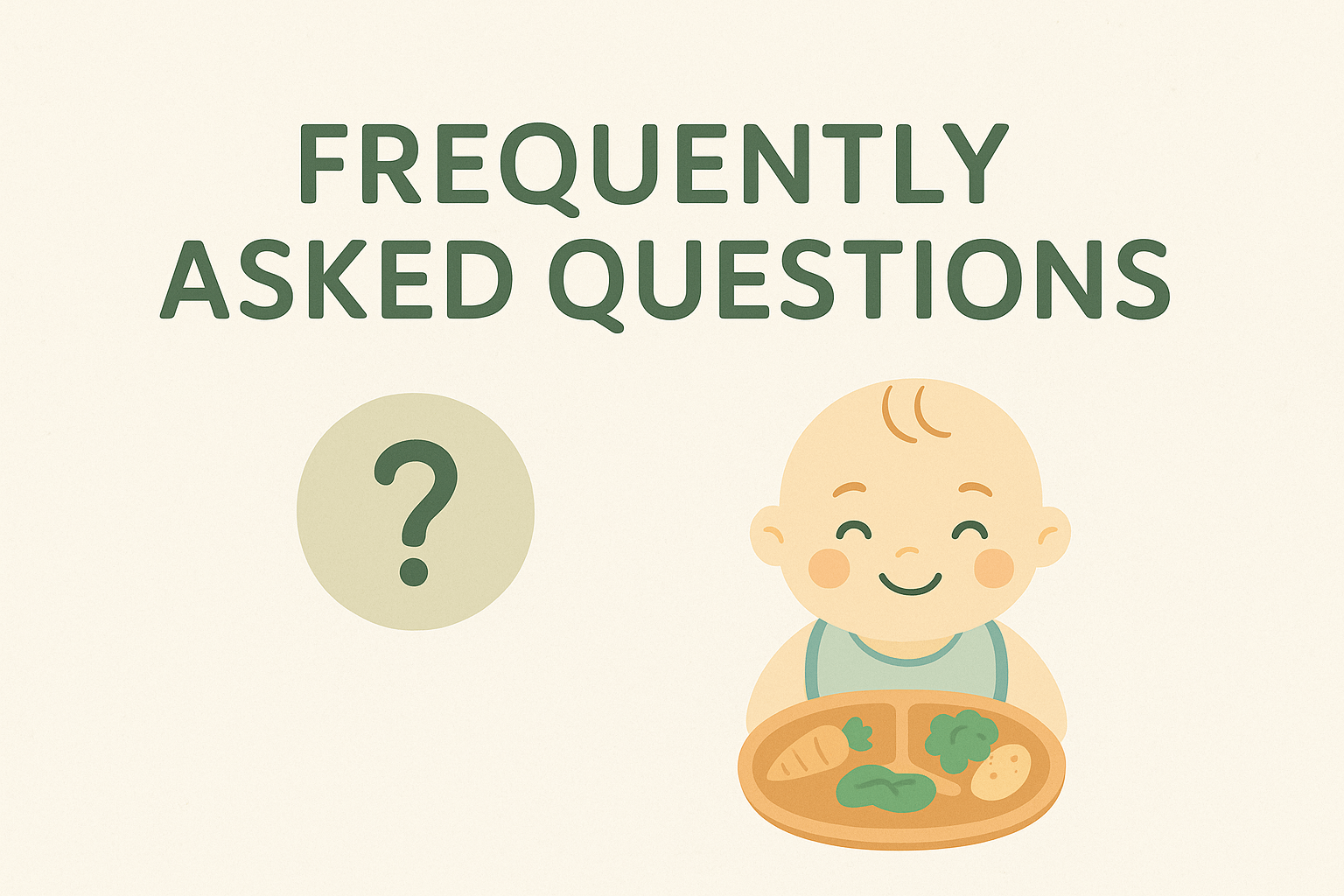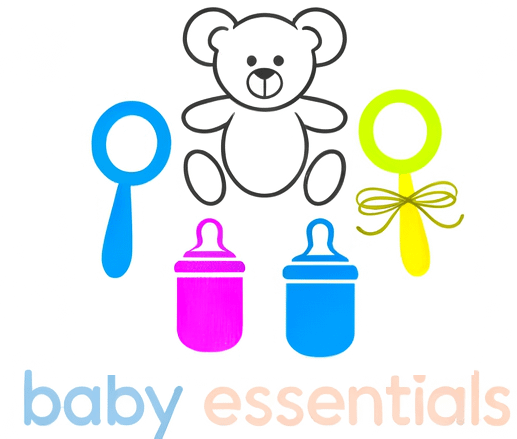Choosing the right mattress for your baby is one of the most important safety decisions you’ll make as a new parent. With babies spending up to 50% of their time sleeping during their first two years, the mattress you select will play a crucial role in your little one’s safety, comfort, and development. This comprehensive guide will walk you through everything you need to know about buying a baby mattress in the UK, from the latest 2025 safety regulations to sizing, materials, and expert recommendations.
⚠️ Critical Safety Message: What Every Parent Must Know
The Lullaby Trust’s Essential Safety Guidance:
The safest mattresses are firm, flat and protected by a waterproof cover. They should be completely flat with no raised or cushioned edges or sides.
NHS Official Recommendation:
Babies need “a firm mattress that fits the cot snugly without leaving spaces around the edges”.
The Statistics That Matter:
There are more than 200 sudden infant deaths every year in the UK. Some research has found a higher risk of SIDS when using a second-hand mattress from outside the family home. Your mattress choice is literally a life-or-death decision.
Why Your Baby’s Mattress Choice Is Critical for Safety
Your baby’s mattress isn’t just about comfort – it’s fundamentally about preventing serious risks, including Sudden Infant Death Syndrome (SIDS) and suffocation. Evidence shows that sleeping a baby on anything but a firm, flat surface or using soft, heavy bedding can increase the risk of sudden infant death syndrome.
Critical Safety Fact: Having a firm mattress reduces the risk of suffocation if your baby rolls onto their face, which is mostly a concern between four and 12 weeks, when rolling over typically begins.
Revolutionary Changes: UK Baby Mattress Safety Regulations 2025
Game-Changing Regulatory Updates Coming October 2025
A landmark change is about to transform the UK baby mattress landscape. The Furniture and Furnishings (Fire) (Safety) (Amendment) Regulations 2025, which will come into force on 30 October 2025, represent a fundamental shift in how baby mattresses are regulated.
The most significant change:
Baby mattresses with dimensions less than 170cm in length and 75cm in width will be exempt from fire safety requirements. This groundbreaking amendment removes the need for chemical flame retardants in baby mattresses, dramatically reducing babies’ exposure to harmful chemicals during their most vulnerable developmental stage.
This statutory instrument was laid in Parliament on 30 April 2025, but in accordance with the United Kingdom’s obligations as a member of the World Trade Organisation (WTO), includes a deferral period of 6 months to fulfil international obligations.
What This Means for Parents Shopping Now vs. After October 2025
If you’re buying before October 30, 2025:
Current mattresses may still contain chemical flame retardants, but all safety standards remain the same.
If you’re buying after October 30, 2025:
New mattresses will have reduced chemical content while maintaining identical safety standards for mechanical and structural safety.
Expert Advice:
The safety requirements for firmness, fit, and construction remain unchanged regardless of when you purchase.
Current Safety Standards You Must Know
Primary Safety Standards
BS EN 16890:2017+A1:2021 remains the primary safety standard for cot mattresses. Released on July 12, 2021, this standard includes rigorous testing for:
- Mechanical hazards, including entrapment, suffocation, and choking risks
- Firmness requirements to prevent suffocation
- Durability to ensure long-term safety
- Hygiene and cleanliness standards
BS EN 716 is the key safety regulation governing baby cots and mattresses in Europe. This standard ensures that baby cots are designed and constructed to provide a secure sleeping environment, minimising risks associated with entrapment, suffocation, or injury.
Critical Safety Testing Requirements
The mattress components have stringent regulations, such as any gaps found in a mattress must pass a probe test to ensure a baby’s fingers can’t get caught in it. There are also rules about the exact sizing of cot mattresses so a baby’s fingers or hands can’t get trapped down the edge, and that the mattress doesn’t exceed 10cm in depth so the baby can’t climb out of the cot.
Standard UK Baby Mattress Sizes and Critical Fit Requirements
UK Standard Mattress Sizes
| Mattress Type | Dimensions | Suitable For | Age Range |
|---|---|---|---|
| Cot Mattress | 120cm x 60cm | Traditional cots | Birth to 18-24 months |
| Cot Bed Mattress | 140cm x 70cm | Convertible cot beds | Birth to 4-5 years |

⚠️ Critical Safety Fit Requirements
BS EN 716 Safety Standard: There should be no more than a 30mm gap between the mattress and the cot frame. This tight fit is necessary to prevent the baby from becoming trapped in any gaps, which could lead to suffocation or other injuries.
How to Measure Safely:
- Take a tape measure and check the length and width of the mattress at multiple places
- Measure both your cot’s internal dimensions precisely
- Ensure the mattress fits with gaps no larger than 30mm (3cm)
- Test fit by trying to insert more than two fingers between the mattress and the frame – if you can, the gap is too large
Safety Alert: Which? Research found that 24% of second-hand mattresses had dangerous gaps between the mattress and cot bed frame, representing a serious entrapment hazard.
Essential Safety Features Every Baby Mattress Must Have
Firmness: The Life-Saving Requirement
Critical Safety Standard: Your baby’s head should sink no more than a few millimetres into a mattress. The mattress should be firm enough that if your baby rolls onto their front, they cannot bury their face into the mattress and suffocate.
How to Test Firmness Properly – Expert Method
The Professional Hand-Press Test:
- Press down firmly on the mattress centre with your palm
- When you press down, there should be resistance, and the mattress should spring back immediately after you remove your hand
- There should be no lasting indentation whatsoever
- Test both the centre and edges for consistent firmness
- If your hand leaves any indentation, the mattress is too soft and unsafe
Critical Safety Data: Which? Research revealed that 9% of new mattresses and 25% of second-hand mattresses developed dangerous indentations during use. This represents a serious suffocation risk and indicates the mattress has lost its essential firmness.
Thickness and Depth Standards
Safety Requirement: UK safety experts recommend that baby mattresses should be between 8-10cm thick. BS EN 716 requires that mattresses don’t exceed 10cm in depth so the baby can’t climb out of the cot.
Waterproof Protection Requirements
Essential Feature: Use a mattress with a waterproof cover. This will help keep the mattress clean and dry because you can wipe the cover. Look for removable, machine-washable covers that can be cleaned at 60°C to eliminate dust mites and bacteria.
Step-by-Step Baby Mattress Decision Framework
Phase 1: Safety Assessment (Non-Negotiable)
Step 1: Verify Safety Standards
- ✅ Confirm BS EN 16890:2017+A1:2021 compliance
- ✅ Look for British Standard certification marks
- ✅ Verify it’s designed specifically for babies (not toddler/child mattresses)
Step 2: Test Firmness Requirements
- ✅ Perform professional hand-press test (no indentation should remain)
- ✅ Ensure the head would sink no more than a few millimetres
- ✅ Check edges are as firm as the centre
Step 3: Measure for Perfect Fit
- ✅ Take a tape measure and check the length and width at multiple places
- ✅ Ensure the mattress fits with a maximum of 30mm gaps
- ✅ Test that you cannot fit more than two fingers in the gaps
Phase 2: Family-Specific Needs Assessment
Step 4: Budget Planning – Expert Sweet Spot
- Expert Recommendation: £100-£150 provides the best balance of safety, quality, and value
- Consider the total cost, including covers and protectors
- Factor in replacement timeline (new baby = new mattress)
Step 5: Material Preferences
- Chemical sensitivity concerns (choose natural fibres)
- Maintenance preferences (removable covers)
- Longevity needs (cot bed vs. cot mattress)
Step 6: Additional Features
- Dual-sided firmness for a growing child
- Hypoallergenic properties, if needed
- Temperature regulation features
Comprehensive Material Guide with Expert Pricing
Foam Mattresses: Enhanced Safety Post-October 2025
Safety Profile: Foam mattresses will become significantly safer after October 2025 due to reduced chemical flame retardant requirements.
Expert Price Range: £20+ for basic foam options
| Advantages | Considerations | Best For |
|---|---|---|
| Lightweight and easy to handle | Quality varies between manufacturers | Budget-conscious families |
| Generally more affordable | May retain heat more than natural materials | Short-term use (cot only) |
| Reduced chemicals after Oct 2025 | Some parents prefer completely natural | First-time parents |
Spring and Pocket Spring Mattresses
Safety Profile: Excellent durability and shape retention, maintaining firmness over extended periods.
Expert Price Range: £50+ for spring combinations
| Families prioritising longevity | Considerations | Best For |
|---|---|---|
| Superior durability and firmness retention | Heavier than foam alternatives | Long-term use (cot beds) |
| Excellent airflow and breathability | Generally more expensive | Families prioritizing longevity |
| Responsive support | May produce slight noise | Parents wanting traditional construction |
Natural Fibre Mattresses: The Chemical-Free Choice
Safety Profile: Completely chemical-free, aligning perfectly with the 2025 regulatory focus on reducing chemical exposure.
Expert Price Range: £100+ for natural materials
| Advantages | Considerations | Best For |
|---|---|---|
| Zero chemical content | Higher initial investment | Chemical-sensitive families |
| Naturally hypoallergenic | May require careful maintenance | Environmentally conscious parents |
| Excellent breathability | Limited availability | Premium quality seekers |
What to Absolutely Avoid: Critical Safety Warnings
❌ Never Use Second-Hand Mattresses
Expert Consensus: We recommend buying a new mattress for each baby. The Lullaby Trust specifically advises against second-hand mattresses.
Dangerous Statistics from Which? Research:
- 25% develop dangerous indentations vs. 9% for new mattresses
- 24% have dangerous gaps vs. 10% for new mattresses
- 27% have broken zips vs. 11% for new mattresses
Health Risk: Some research has found a higher risk of SIDS when using a second-hand mattress from outside the family home.
❌ Dangerous Products to Avoid Completely
- Memory Foam: Temperature-sensitive properties create suffocation risks
- Sheepskin Linings: Don’t use a sheepskin to line the cot, Moses basket or other sleep space
- Pods or Nests: We don’t recommend pods or nests as sleeping babies should not lie on or have anything soft around their heads
- Overly Soft Surfaces: Any mattress described as “plush,” “soft,” or “cushioned”
Comprehensive Maintenance and Troubleshooting Guide
Monthly Safety Inspection Checklist
Visual Inspection:
- ✅ Check for sagging or permanent indentations
- ✅ Examine the cover for tears or holes
- ✅ Verify all components are securely attached
- ✅ Assess fit within the cot frame (maximum 30mm gaps)
Firmness Testing:
- ✅ Perform hand-press test monthly using the expert method
- ✅ Check that the mattress springs back immediately after removing your hand
- ✅ Ensure no lasting indentations remain
Hygiene Assessment:
- ✅ Check for persistent odours
- ✅ Examine waterproof cover condition
- ✅ Verify cleaning effectiveness at 60°C
Cleaning and Maintenance Schedule
Weekly:
- Wipe the waterproof cover with a damp cloth
- Check for spills or stains requiring immediate attention
Monthly:
- Remove and wash the cover at 60°C (if removable)
- Rotate the mattress to ensure even wear
- Perform a comprehensive safety inspection
Every 3 Months:
- Deep clean according to the manufacturer’s instructions
- Assess overall condition and firmness
- Check the cot fit measurements using a tape measure at multiple places
Troubleshooting Common Issues
Problem: Mattress Feels Softer Than When New
- Immediate Action: Perform an expert hand-press test
- If Indentation Remains: Replace immediately – this is a suffocation hazard
- Prevention: Rotate regularly, avoid excessive moisture
Problem: Gaps Appearing Between Mattress and Cot
- Immediate Action: Measure gaps with a ruler at multiple points
- If over 30mm: Stop using immediately and replace
- Cause: Mattress shrinkage or cot frame expansion
Problem: Persistent Chemical Odours
- New Mattress: Allow 24-48 hours for ventilation in a well-ventilated room
- If odour persists: Contact the manufacturer – may indicate a defect
- Never Use: If a strong chemical smell doesn’t dissipate
Problem: Waterproof Cover Damage
- Minor Tears: Replace the cover immediately to maintain hygiene
- Major Damage: May require full mattress replacement if core is compromised
When Immediate Replacement is Essential
Replace Immediately If:
- ❌ Fails expert hand-press test (indentation remains after removing hand)
- ❌ Gaps exceed 30mm between the mattress and the cot frame
- ❌ Visible sagging or permanent deformation
- ❌ Contamination that cannot be cleaned at 60°C
- ❌ Persistent chemical odours after 48 hours
- ❌ Any structural damage to the mattress core

Budget Planning with Expert Value Analysis
Complete Cost Breakdown by Category
| Price Range | Features Included | Typical Lifespan | Expert Recommendation |
|---|---|---|---|
| £50-£100 | Basic foam, meets safety standards, basic cover | 12-18 months | Budget option, plan for replacement |
| £100-£150 | Premium springs or natural fibres, dual-sided, superior covers | 2-3 years | Expert Sweet Spot – Best Value |
| £150-£250 | Premium springs or natural fibers, dual-sided, superior covers | 3-5 years | Long-term investment |
| £250-£300+ | Premium natural materials, custom features, extended warranties | 5+ years | Premium chemical-free choice |
Total Cost of Ownership Calculator
Basic Setup Costs:
- Mattress: £50-£300
- Waterproof protector: £15-£30
- Spare covers (if available): £20-£40
- Total Initial Investment: £85-£370
Ongoing Costs:
- Replacement protectors: £15-£30 annually
- Professional cleaning (if needed): £30-£50
- Early replacement (if quality issues): £50-£300
Expert Value Optimisation Strategies
- Best Value Approach: Invest £100-£150 in a quality mattress with a removable, washable cover
- Premium Strategy: Choose a £200+natural fibre mattress for chemical-free peace of mind
- Budget Strategy: Select a £50-£80 foam mattress meeting all safety standards, plan for earlier replacement
Expert Recommendations for 2025
Top Safety-Focused Recommendations
- Best Overall Safety Compliance: Look for mattresses specifically tested to BS EN 16890:2017+A1:2021 with clear certification documentation.
- Best for Chemical-Conscious Parents: Natural coir and latex mattresses offer complete chemical-free peace of mind, especially important before October 2025 regulatory changes.
- Best Budget Safety Option: Quality foam mattresses meeting all safety standards, with improved safety profiles expected after October 2025.
- Best Long-Term Investment: Dual-sided cot bed mattresses (140x70cm) offering different firmness levels for newborns and toddlers.
Decision Matrix for Different Family Situations
First-Time Parents on a Budget:
- Priority: Safety compliance + affordability
- Recommendation: £80-£120 foam mattress with removable cover
- Key Features: BS EN 16890 compliance, firm construction, waterproof cover
Chemical-Sensitive Families:
- Priority: Natural materials + zero chemical exposure
- Recommendation: £200+ natural fiber mattress
- Key Features: Organic cotton, coir, or latex construction
Long-Term Planning for Families:
- Priority: Durability + growing child adaptability
- Recommendation: £150-£250 dual-sided cot bed mattress
- Key Features: Different firmness levels, superior construction
Making Your Final Decision: Complete Safety Checklist
Pre-Purchase Safety Verification
Essential Safety Standards:
- ✅ BS EN 16890:2017+A1:2021 compliance confirmed
- ✅ BS EN 716 Cot safety standard alignment
- ✅ British Standard certification visible
Physical Safety Requirements:
- ✅ Firmness test passed using expert hand-press method (no indentation from hand pressure)
- ✅ Correct size for your specific cot (120x60cm or 140x70cm)
- ✅ Thickness between 8-10cm
- ✅ Waterproof cover included or available
Fit and Installation Safety:
- ✅ Gaps between the mattress and the cot frame under 30mm (measured at multiple places)
- ✅ Cannot fit more than two fingers in any gap
- ✅ Mattress sits flat with no raised edges
Post-Purchase Safety Setup
Installation Checklist:
- ✅ Remove all packaging materials completely
- ✅ Allow 24-48 hours for any odours to dissipate
- ✅ Install a waterproof protector before first use
- ✅ Verify final fit measurements in the cot using a tape measure
First Month Monitoring:
- ✅ Perform weekly firmness checks using the expert method
- ✅ Monitor for any changes in fit
- ✅ Check for any unusual odours or changes
- ✅ Ensure baby is sleeping safely (feet to foot position)
Conclusion: Your Baby’s Safety Is Worth the Investment
The upcoming October 2025 regulatory changes will make baby mattress shopping both simpler and safer for UK parents. With reduced chemical exposure requirements and continued rigorous safety standards, you can choose a mattress with confidence knowing it meets the latest safety requirements.
Remember the Critical Safety Requirements:
- Firm, flat mattress with waterproof cover (The Lullaby Trust guidance)
- Perfect fit with no more than 30mm gaps (BS EN 716 standard)
- The head sinks no more than a few millimetres (NHS recommendation)
- Always buy new rather than second-hand for optimal safety
Expert Budget Guidance: The £100-£150 price range provides the optimal balance of safety, quality, and value for most families. Whether you choose a basic foam mattress, benefiting from reduced chemical content or invest in a premium natural fibre option, the most important factors remain safety compliance and proper construction. Your baby will spend thousands of hours on this mattress during their most vulnerable developmental period. This investment in their safety and well-being is one of the most important you’ll make as a parent. Take time to measure your cot precisely using a tape measure at multiple places, understand the safety requirements, and don’t hesitate to contact manufacturers with questions about compliance with current safety standards. When in doubt, prioritise safety over cost – your baby’s life depends on getting this decision right.

FAQs: The Complete Baby Mattress Buying Guide
What makes a baby mattress safe?
The safest mattresses are firm, flat and protected by a waterproof cover. They should be completely flat with no raised or cushioned edges or sides. Your baby’s head should sink no more than a few millimetres into a mattress. The mattress must fit the cot snugly with no more than 3cm gaps between the mattress and the cot frame to prevent entrapment.
Should I buy a new mattress or can I use a second-hand one?
Always buy a new mattress for each baby. We do not recommend buying or using a second-hand cot mattress. Research shows that cot mattresses can lose more than 25% of their firmness in just a few years of use. Some research has found a higher risk of SIDS when using a second-hand mattress from outside the family home.
What’s the difference between cot and cot bed mattress sizes?
A traditional cot fits a 60cm x 120cm mattress, whereas a cot bed fits a 70cm x 140cm mattress. The standard dimensions for UK cot bed mattresses are 140 x 70cm, while 120 x 60cm is typically for cots that do not convert to toddler beds. Always measure your cot’s internal dimensions before purchasing.
How firm should a baby mattress be?
A baby mattress should be firm and supportive. You can test firmness by pressing on the mattress centre and edges – it should spring back quickly. A firm mattress provides support for healthy bone development and reduces the risk of suffocation. If the sleeping surface is too soft, your newborn may get stuck in a dangerous position.
What thickness should I choose for a baby mattress?
The recommended thickness for a baby mattress is between 8-10cm. We recommend that your baby’s cot mattress is at least 10cm thick to ensure your baby’s weight doesn’t cause sagging through to the base underneath. This thickness provides adequate support without compromising safety.
Are foam or spring mattresses better for babies?
Spring mattresses offer more support for longer and are well-suited for cot beds used for children up to 4 years old. Foam mattresses tend to be cheaper, but some manufacturers prefer to avoid foam and chemicals, opting instead for polyester fibres or spring systems. The most important factor is ensuring the mattress meets safety standards, regardless of material.
What additional features should I look for?
Look for mattresses with waterproof covers that can be wiped clean. Choose breathable and hypoallergenic materials. Ensure the mattress has proper ventilation and consider removable, machine-washable covers. The mattress should be tested to UK safety standards and be foam and chemical treatment-free for a purer sleeping environment.
CuddleCo Lullaby Hypo-Allergenic Bamboo Cot Bed Mattress – Rated as “Best cot mattress overall” by Mother & Baby magazine

Award-winning 2025 baby mattress with dual-sided design and natural hypo-allergenic properties. Features breathable bamboo fibers for temperature regulation and waterproof side for easy transitions. Two-time Mother&Baby Gold winner.
- ✅ Dual-sided: soft & waterproof
- ✅ Natural anti-microbial protection
- ✅ Perfect temperature regulation
- ✅ Award-winning safety & comfort
Further Reading
- What to Look for in a Cot
- Essential Baby Sleep Tips for New Parents
- Ickle Bubba Snowdon Mini Cot Bed Review: Stylish 4-in-1 Convertible Design
- UK Baby Product Safety Standards 2025: Your Complete Parent’s Guide
- Snuz SnuzPod4 Bedside Crib
- Your Guide to Safe Sleep for Baby (2025 Update)
- Understanding Baby Sleep Cycles: A Comprehensive Guide for Parents
References
- The Lullaby Trust – Baby mattresses and bedding safety guidance
- NHS – Safe sleeping for babies guidance
- UK Government – Furniture and Furnishings (Fire) (Safety) (Amendment) Regulations 2025
- BS EN 16890:2017+A1:2021 Children’s furniture – Mattresses for cots and cribs safety requirements
- BS EN 716 European safety standard for baby cots
- Which? – Are you using an unsafe cot mattress for your baby?
- Picket and Rail – Baby Cot & Mattress Safety Standards of BS EN 716
- Interior Daily – New fire safety rules announced for UK furniture industry
- John Ryan By Design – Cot Mattress Safety Requirements
- MattressOnline – Mattress buying advice for babies
- NHS Benfleet PCN – Baby Safe Sleeping guide
- UK Government – Furniture and furnishings fire safety regulations
- Intertek – UK Published Amendments to Fire Safety Regulations
- The Royal Society for the Prevention of Accidents (RoSPA) – Baby sleep safety
- Lullaby Trust – Safer sleep for babies research and guidance

